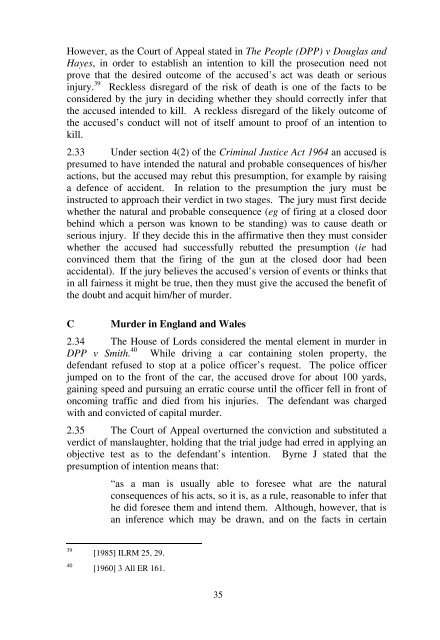murder and involuntary manslaughter - Law Reform Commission
murder and involuntary manslaughter - Law Reform Commission
murder and involuntary manslaughter - Law Reform Commission
You also want an ePaper? Increase the reach of your titles
YUMPU automatically turns print PDFs into web optimized ePapers that Google loves.
However, as the Court of Appeal stated in The People (DPP) v Douglas <strong>and</strong>Hayes, in order to establish an intention to kill the prosecution need notprove that the desired outcome of the accused’s act was death or seriousinjury. 39 Reckless disregard of the risk of death is one of the facts to beconsidered by the jury in deciding whether they should correctly infer thatthe accused intended to kill. A reckless disregard of the likely outcome ofthe accused’s conduct will not of itself amount to proof of an intention tokill.2.33 Under section 4(2) of the Criminal Justice Act 1964 an accused ispresumed to have intended the natural <strong>and</strong> probable consequences of his/heractions, but the accused may rebut this presumption, for example by raisinga defence of accident. In relation to the presumption the jury must beinstructed to approach their verdict in two stages. The jury must first decidewhether the natural <strong>and</strong> probable consequence (eg of firing at a closed doorbehind which a person was known to be st<strong>and</strong>ing) was to cause death orserious injury. If they decide this in the affirmative then they must considerwhether the accused had successfully rebutted the presumption (ie hadconvinced them that the firing of the gun at the closed door had beenaccidental). If the jury believes the accused’s version of events or thinks thatin all fairness it might be true, then they must give the accused the benefit ofthe doubt <strong>and</strong> acquit him/her of <strong>murder</strong>.CMurder in Engl<strong>and</strong> <strong>and</strong> Wales2.34 The House of Lords considered the mental element in <strong>murder</strong> inDPP v Smith. 40 While driving a car containing stolen property, thedefendant refused to stop at a police officer’s request. The police officerjumped on to the front of the car, the accused drove for about 100 yards,gaining speed <strong>and</strong> pursuing an erratic course until the officer fell in front ofoncoming traffic <strong>and</strong> died from his injuries. The defendant was chargedwith <strong>and</strong> convicted of capital <strong>murder</strong>.2.35 The Court of Appeal overturned the conviction <strong>and</strong> substituted averdict of <strong>manslaughter</strong>, holding that the trial judge had erred in applying anobjective test as to the defendant’s intention. Byrne J stated that thepresumption of intention means that:“as a man is usually able to foresee what are the naturalconsequences of his acts, so it is, as a rule, reasonable to infer thathe did foresee them <strong>and</strong> intend them. Although, however, that isan inference which may be drawn, <strong>and</strong> on the facts in certain3940[1985] ILRM 25, 29.[1960] 3 All ER 161.35
















